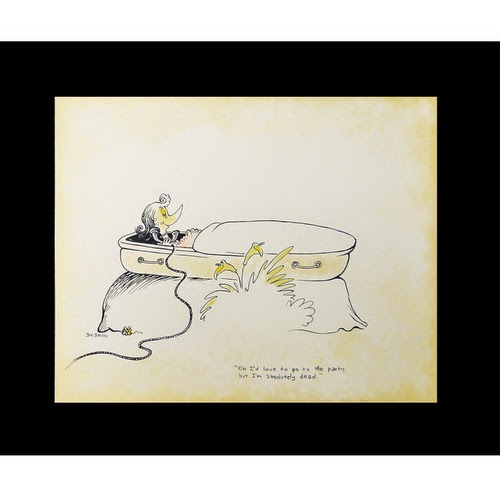 |
|
Hotel del Coronado records the view outside Geisel’s studio window.
|
I can’t imagine there’s an American alive who isn’t familiar with the works of Dr. Seuss (Theodor Geisel). Several generations of children have learned to read with his books and his drawings are ubiquitous.
 |
|
Gosh! Do I Look as Old as All That! is part of an 11-painting series gently mocking La Jolla matrons.
|
The world as seen by Dr. Seuss is strange, but it might look a bit less odd to a native of San Diego. Geisel modeled his palms and acacias, brightly-plumed birds and bright landscapes on the Southern California scene.
 |
| Martini Bird, Theodor Geisel (Dr. Seuss) |
Geisel lived in La Jolla, an upscale seaside neighborhood in San Diego, from 1953 until his death in 1991. There he wrote most of his classic children’s tales including The Cat in the Hat, Horton Hears a Who, How the Grinch Stole Christmas, Green Eggs and Ham, and The Lorax.
 |
| Raising Money for the Arts, Theodor Geisel (Dr. Seuss) |
Like so many 20th-century book illustrators, he learned his craft through advertising, drawing for General Electric, NBC, Standard Oil, and other companies.
 |
|
Cat Behind the Hat, Theodor Geisel (Dr Seuss)
|
Dr. Seuss liked to paint at night after he was done writing and illustrating during the day. Unlike most artists with a bifurcated work life, his personal paintings aren’t clearly different from his story books. This couldn’t have been because his life was smooth sailing: his first wife, Helen Palmer Geisel, committed suicide in despair over illness and her husband’s burgeoning affair with her close friend. Geisel served in the First Motion Picture Unit of the Army in the Second World War and lived through all of the epochal, cataclysmic events of the 20th century. But none of that shows in his work. It is unfailingly gentle and shallow, although marginally more adult.
 |
|
Lion Stroll, Theodor Geisel (Dr. Seuss)
|
Ingenious! The World of Doctor Seuss is an exhibit of reproductions of his paintings and sculpture. (His widow refuses to allow any of his original work to be displayed.) It runs at the San Diego History Center until the end of 2015.
 |
|
Oh, I’d Love to go to the Party, but I’m Absolutely Dead, Theodor Geisel (Dr. Seuss)
|
Let me know if you’re interested in painting with me on the Schoodic Peninsula in beautiful Acadia National Park in 2015 or Rochester at any time. Click here for more information on my Maine workshops! Download a brochure here.

























